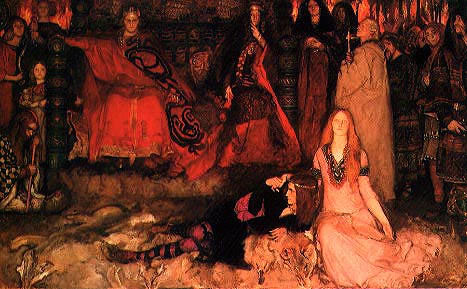![]()
Perspectives
These two Nineteenth Century images of the play scene in Hamlet illustrate two diametrically opposite perspectives of the same scene. In some respects, they symbolically demonstrate the great diversity of perspectives possible in viewing the scene.

The Play Scene in Hamlet by Daniel Maclise (1842)
Watercolor, body color and varnish on paper, 14.25 x 25.5 inches. Forbes Magazine
Collection, New York, New York. This water color is a replica of the painting
Maclise exhibited in the 1842 Royal Academy Exhibition. The original is oil
on canvas, 60 x 108 inches. Tate Gallery, London
The painting reflects the understanding of the scene commonly held by the Romantics. All eyes are on stage except those of Hamlet, Horatio, Claudius and Ophelia. Ophelia sits demurely (perhaps chastened by the humiliation of having Hamlet subject her to dirty jokes in public). But Hamlet and Horatio have their gaze fixed on Claudius who appears to be agonizing over the content of the play while Gertrude, sitting at his side, is caught up in the drama and fails to notice his distress. Along the walls are four tapestries depicting scenes from Genesis; they are the temptation, the expulsion from the garden, the sacrifice of Abel, and, most significant, the murder of Abel by Cain. The statue above the head of Ophelia is a figure representing Prayer, and the statue above the head of the king and queen is Justice.

Edwin Austin Abbey, Hamlet (1897)
Oil on canvas, 61.25 x 96.5 inches. Yale University, New Haven.
In Abbey's painting, exhibited at the 1897 Royal Academy exhibition,
the viewer is put on stage, looking out at the audience. The torches, which
presumably light the stage, cast a sinister glow on the audience, creating
the demonic atmosphere of the painting.
Abbey displays a gift for making facial expressions and physical reactions
central to his painting. Everyone faces the stage, with the exception of Hamlet
and Horatio (the figure at the far right), who study Caladium's reactions.
Claudius' stern gaze betrays no emotion while Gertrude, on the other hand,
distances herself from Claudius, shrinking into a corner, and drawing her
veil about her face. Ophelia, judging by her benign, open expression, has
no idea of the meanings those around her attach to the play they watch.